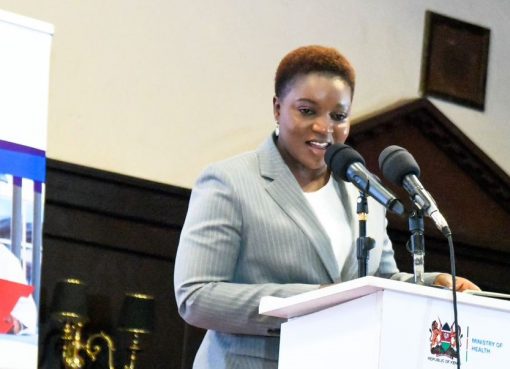The Government is committed to supporting the creative industry which plays a key role in not only fostering creative thinking but also addressing high unemployment rates.
Nakuru County Commissioner Mr Loyford Kibaara said the government has identified the creative economy as one of the fastest sectors not only as a source of employment but also an enabler of national cohesion and innovation.
The Economic Survey 2023 had revealed that the arts, recreation and entertainment industry creates jobs, accounts for 5 percent of the Gross Domestic Product (GDP) and 0.25 percent of total wage employment. It was also identified as a contributor to a happier and healthier lifestyle.
Mr Kibaara who was speaking during the launch of the sixth edition of the Kenya Universities Performing Arts Association (KUPAA) National Drama and Performing Arts Festival at Egerton University’s Njoro Main Campus added that recognising the significant impact of Kenya’s creative sector individuals, corporations and stakeholders must come together in collaborative efforts to harness and maximize the creative talent.
The administrator who was flanked by Egerton University’s Vice Chancellor Professor Isaac Kibwage, stated that with the implementation of the Competency Based Curriculum (CBC), there is realization that in the current age of technological leaps like Artificial Intelligence (AI) future jobs will heavily rely on art and creative work.
“Through art and creativity, we can create new industries and job opportunities. What we need are many artists and creative individuals to become entrepreneurs by starting their own businesses or ventures related to their craft. This enterprising spirit will lead to self-sustaining careers and economic independence,” noted the County Commissioner.
The KUPAA event brings together students from both public and private universities across Kenya to showcase their passion and skill in the performing arts.
While lauding the event, Mr Kibaara observed that the festival not only celebrates the vibrancy of creative expression in academia but also marks a significant step toward fostering a culture of arts within Kenya’s higher education system.
“The festival provides an important platform for students to tackle critical social issues through their art, promoting conversations around identity, resilience, and community. For the audience, it is a vivid reminder of the value of the arts in highlighting societal issues and fostering empathy,” the official pointed out.
Mr Kibaara pledged that the government is determined to help the players in the sector realize the vast opportunities in the sector and that it was working on projects that will see the industry grow.
“The government has banked on programmes to enhance the development of the creative economy using the digital platforms and by extension enhance its development,” added the administrator.
At the same time, the County Commissioner challenged artists to create content that identifies with African culture as it will speak to African values and will help in promoting local content internationally.
He said, “Create content that speaks to our African values to tap the market, don’t chase Europe or America as you will not do better than they do”.
He observed that the creative sector is punching lower than its full potential yet it presents a myriad of opportunities that can make us tap into this “emerging high-growth areas of the world economy”.
“Works of art such as music, story-telling, film and poetry, theatre and performing arts are powerful tools for promoting Kenya’s cultural diversity and cohesion as well as an avenue for job and wealth creation,” he said.
The host university Vice Chancellor Professor Kibwage lauded KUPAA for spearheading the festival, which he said, provides learners with opportunities to not only showcase their talents, but also inspires them to exploit their talents for job opportunities and wealth creation.
“We are happy as an institution to have hosted both the regional and national festivals,” said Professor Kibwage.
He thanked the government for championing the passing of legislative policies that will favour players in the arts industry.
He said time has come for creatives to make a meaningful life out of their art noting that the State had put in place strategies that will open opportunities for all creatives and protect their Intellectual Property from exploitation.
“This is really great news for the creatives that the State is working on a comprehensive legal framework to manage this space. We should be able to monetise that space. Actually, creatives’ talent should be their source of livelihood. They should make good money and live well doing what they are doing,” Professor Kibwage noted.
He noted that Kenya’s creative economy presents economic and cultural opportunities that require development.
The Vice Chancellor indicated that businesses in the arts, entertainment and recreation sector, as established in Kenya’s 2016 Micro, Small, and Medium Enterprises (MSME) survey, had the highest average life (of 10.1 years) when compared to businesses in other industrial sectors.
Professor Kibwage was happy that introduction of prime arts and comedy segments in nearly all television stations was a clear indication that art was becoming a paying venture adding that besides the performing arts, visual arts and cultural heritage, Kenyans were now producing films, videos, television and radio shows, video games, music and books which were increasingly becoming popular among Kenyans both in urban and rural set-ups.
KUPAA chairman Mr Bonface Isalambo underscored the importance of investing in the creative industry as a driver of economic growth and global recognition, noting that culture is central to Nakuru’s identity and a valuable resource for fostering community cohesion.
He observed that art was critical in expressing emotions, communicating ideas and transmitting knowledge from one generation to another and advised that the best way of encouraging progressive thinking and innovative ideas to advance a ‘creative economy’ was cultivating young people’s imagination and creativity.
Kenya Universities Performing Arts Association (KUPAA) National Drama and Performing Arts Festival added Mr Isalambo is aimed at creating a platform for industry players and stakeholders to learn, share and celebrate their diverse artistic creations and also leverage these talents to advocate for national cohesion in society.
He said the event has been used as a forum to promote artistic expression for national cohesion and sustainable development as participants will show off their raw talent and novel ideas.
“This has not only given visual and performing artists a platform to showcase their work but also provide a marketing venue for products,” he added.
Consequently, the official said the event has promoted teamwork and unity and plays a pivotal role in the celebration of the country’s cultural heritage as the youth participate in activities key in supporting livelihoods and the empowerment of their immediate communities.
At the same time, the official said it was important for students to fully utilise homegrown talent in all their events as art was an expressive, non-threatening way to express inner feelings adding that KUPAA was committed to promoting and protecting local artists against exploitation and providing opportunities for young people to explore music, drama, dance, film, art and fashion.
He hailed the Youth Affairs, Sports and Arts Ministry’s announcement to the effect that it was preparing a new legal framework to protect Kenyan creatives and the industry.
For too long, culture and arts have been made marginal to national development due to conservative attitudes of what they entail.
Cultural experts have however indicated that limiting culture to tradition and ethnography denies the nation the opportunities provided by the imagination, technological advances, rapid urbanization and the energies released by cultural interconnectedness.
Kenya’s creative sector evolution is attributable to many factors including the expanded digital environment, characterised by increased consumption of creative works, improved internet infrastructure, better legislative framework, and a growing global interest in Africa’s creative sector.
Collectively, these factors have created opportunities for diverse revenue streams, especially for the youth who make the biggest number in the population and whose innovative and creative talents have thousands seeking entrepreneurship opportunities for the betterment of their livelihoods.
By Anne Mwale





